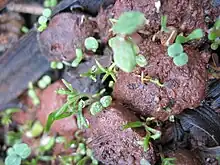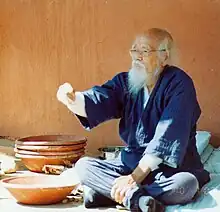Seed ball
Seed balls, also known as earth balls or nendo dango (Japanese: 粘土団子), consist of seeds rolled within a ball of clay and other matter to assist germination. They are then thrown into vacant lots and over fences as a form of 'guerilla gardening'. Matter such as humus and compost are often placed around the seeds to provide microbial inoculants. Cotton-fibres or liquefied paper are sometimes added to further protect the clay ball in particularly harsh habitats. An ancient technique, it was re-discovered by Japanese natural farming pioneer Masanobu Fukuoka.
.jpg.webp)

Development of technique

The technique for creating seed balls was rediscovered by Japanese natural farming pioneer Masanobu Fukuoka.[1] The technique was also used, for instance, in ancient Egypt to repair farms after the annual spring flooding of the Nile. Masanobu Fukuoka developed his technique during the period of the Second World War, while working in a Japanese government lab as a plant scientist on the mountainous island of Shikoku. He wanted to find a technique that would increase food production without taking away from the land already allocated for traditional rice production which thrived in the volcanic rich soils of Japan.[2][3]
Construction
.jpg.webp)
To make a seed ball, generally about five measures of red clay by volume are combined with one measure of seeds. The balls are formed between 10 mm and 80 mm (about 1⁄2" to 3") in diameter. After the seed balls have been formed, they must dry for 24–48 hours before use.
Seed bombing
Seed bombing is the practice of introducing vegetation to land by throwing or dropping seed balls. It is used in modern aerial seeding as a way to deter seed predation. It has also been popularized by green movements such as guerrilla gardening as a way to introduce new plants to an environment.
Guerrilla gardening
The term "seed green-aide" was first used by Liz Christy in 1973 when she started the Green Guerillas.[4] The first seed green-aides were made from condoms filled with tomato seeds, and fertilizer.[5] They were tossed over fences onto empty lots in New York City in order to make the neighborhoods look better. It was the start of the guerrilla gardening movement.[6]
See also
- The One-Straw Revolution
- Miss Rumphius by Barbara Cooney, a 1982 children's book emphasizing public seed scattering
- Seed dispersal
- Johnny Appleseed
- Operation Overgrow
- Diggers
References
- Adler, Margot (April 15, 2009). "Environmentalists Adopt New Weapon: Seed Balls". NPR. Retrieved November 9, 2011.
- Fukuoka (福岡), Masanobu (正信) (May 1978) [1st publ. in Japanese September 1975], Larry Korn (ed.), The One-Straw Revolution An Introduction to Natural Farming, translated by Chris Pearce; Tsune Kurosawa; Larry Korn, Emmaus, Pennsylvania: Rodale Press, ISBN 0878572201
- Fukuoka (福岡), Masanobu (正信) (December 1987) [1st publ. in Japanese December 1975], The Natural Way of Farming The Theory and Practice of Green Philosophy, translated by Frederic P Metreaud (rev. ed.), Tokyo: Japan Publications, ISBN 978-0-87040-613-3
- "Our History | Green Guerillas". www.greenguerillas.org. Retrieved 2017-12-31.
- "How Guerrilla Gardening Works". How Stuff Works. Retrieved 2017-09-12.
- Robinson, Joe (29 May 2008). "Guerrilla gardener movement takes root in L.A. area". L.A. Times. Retrieved 12 June 2014.
Further reading
- Smith, K. (2007). The guerilla art kit. Princeton Architectural Press.
- Huxta, B. (2009). Garden-variety graffiti. Organic gardening, 2009.
External links
- "横浜アートプロジェクト". "What's a clay ball?" and "Clay Ball Method" advice derived directly from Fukuoka Masanobu by The RainMaker Project, a major project in Africa by Yokohama Art Project, Japanese NGO.
- "Paper/Seed-unified planting seed unit and preparation process thereof" (PDF). Masanobu Fukuoka's patent for advanced seedballs
- "X1seed~1". Archived from the original on 2006-04-11. Making Seed Balls, by Jim Bones, he learned personally from Fukuoka Masanobu and from his books.
- "Seed Ball Story". YouTube.</ref> The Seed Ball Story, a video by Jim Bones about desert habitat restoration using seed balls in Big Bend National Park, Texas.
- "6seedpa". Archived from the original on 2006-01-07. The entire "Lost Seed Ball Pages" by Jim Bones, An early overview of seed ball production and uses, including instructions for making a von Bachmayr Rotary Drum.
- "Seed Balls R Us" A crossroads website dedicated to sharing seed ball information links and videos.
- "Masanobu Fukuoka Makes Seed Balls". YouTube. "Seed Balls by Masanobu Fukuoka 1997" YouTube 18:43 long video, caption: "Natural Farmer Masanobu Fukuoka conducts a workshop for making seed balls at his natural farm and forest in Japan."
- Making Hay with Clay - Greece
- "How To Make A Seedball". www.seedball.com.
- "Which Type of Seed Ball?". A discussion of the pros and cons of different seed ball recipes
- "On Seedballs". a website dedicated to seedballs
- "Seed Bomb R&D".
- "Stuff You Should Know".
- "How to Make a Seed Bomb". Wikihow.com
- "How to make seed bombs". Los Angeles Times.
- "DIY: Make Your Own Wildflower Seed Bombs". 16 May 2019. Gardenista.com
- Articles.washingtonpost.com
- "Guerrilla gardening | Permanent Culture Now".
- "How guerrilla gardening took root". 15 March 2010.
- "Tending 'Defiant Gardens' During Wartime". NPR.org.
- "BBC News | E-CYCLOPEDIA | Guerrilla gardening: Resistance is fertile".
- "Seedbombs are weapon of choice in war against wastelands | Leo Hickman". TheGuardian.com. 11 April 2011.
- Domokos, John (24 April 2008). "Video: The guerrilla gardener's seedbomb recipe". The Guardian.
- "Planning a Seed Bomb Strike".